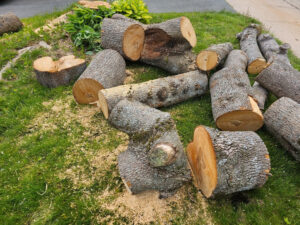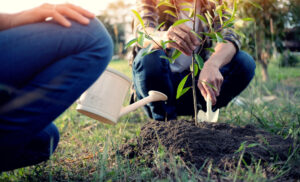Preparing Your Yard for Tree Removal: A Comprehensive Guide
A major project, tree removal calls for meticulous planning and preparation to guarantee safety, save other plants, and preserve the integrity of your landscape. Making room for building, removing a sick tree, or just changing up your outdoor space—proper planning is crucial. We’ll lead you through every stage of getting your yard ready for tree removal in this comprehensive guide, so the procedure goes well from beginning to end.
Thorough preparation of your yard is essential before starting the tree removal procedure. This preparation helps to keep your landscaping looking good and the health of the plants around it intact in addition to making the removal process safer and more effective.
For a variety of reasons, include removing safety risks, treating disease or damage, or creating space for new landscaping projects, trees may need to be removed. For the reason, getting your yard ready guarantees the removal process goes as smoothly and safely as possible.
Clearing the Area
Making room around the tree is the first stage in getting ready to remove it. This is taking out any furniture, outdoor décor, gardening equipment, or other things that could block the way to the tree or be dangerous to remove. To make sure the tree won’t fall onto surrounding buildings, plants, or utilities, clearing the area also involves defining its border.
Clearing the space protects your property and reduces any harm, not just provides a workspace for the tree removal experts. You make it safe and clear for the removal crew to work effectively by clearing out obstructions and delineating limits.

Pruning and Trimming
Tree removal should only be started after the tree has been carefully pruned. Pruning is the process of removing branches or limbs only to enhance the structure, health, and beauty of a tree. Contrarily, trimming is the process of pruning overgrown branches to lighten their weight and provide the removal crew easier access.
In getting ready to remove a tree, pruning and trimming have various crucial functions. They lower the possibility, to start, of branches breaking off during the removal procedure, which could result in injury or property damage. Second, they offer a better look at the structure of the tree, which enables the removal crew to evaluate possible hazards and organize the safest method of removal.
Pruning and trimming should be done by licensed arborists or tree care experts who are aware of the particular requirements of the tree species and the best methods to support the health and safety of the tree.
Safety Precautions
Tree removal is by nature dangerous; it involves big machinery, falling debris, and possible dangers to one’s own safety as well as property. For a seamless and incident-free removal procedure, thorough safety measures must therefore be taken.
Wearing the right safety equipment is crucial before starting any tree removal task, as is equipping any staff members. This covers, among other things:
Protective hard helmets against falling debris:
- Goggles or glasses to protect eyes from dust and wood chips.
- Heavy-duty gloves to protect hands when handling machinery or trash.
- Hardwearing, non-slip shoes to keep you steady on uneven ground.
- If using loud tools like chainsaws or wood chippers, wear ear protection.
- Apart from personal protection equipment (PPE), it is imperative to create a well defined work zone around the tree.
- Setting limits and managing admission to the removal area protects onlookers and nearby properties from unwanted invasion.
For bigger trees or more involved removal jobs, think about using expert tree removal services. Skilled arborists are equipped for the task, have received training in safe tree removal methods, and have liability insurance to guard against possible mishaps or property damage.
Protecting Surrounding Plants
Proactive steps must be made during the tree removal process to shield nearby plants and flora from any harm. Trees and bushes close to the removal site may be at risk from falling debris, moving equipment, or disturbance of the soil brought on by the operation.
To safeguard your garden and landscape:
- Tarps or light-weight sheets can be used to protect fragile plants from dust, wood chips, and falling branches.
- To reduce the chance of inadvertent injury, prune and trim surrounding plants before the removal starts.
- Tell your removal crew where sensitive plants are and what certain safety measures must be done to prevent injury.
- Following these safety measures helps to preserve the general health and beauty of your landscape after removal in addition to safeguarding your current vegetation.

Removing Debris
There will be a good deal of debris left over after the tree is properly removed. Debris removal done correctly is necessary to keep your yard safe and tidy.
Several disposal choices are available to you depending on the size and amount of debris:
- To properly gather and dispose of the tree fragments, call in a seasoned waste removal company.
- Make mulch or compost in your garden using the wood chips and smaller branches.
- For use in woodworking projects, firewood, or other creative endeavors, save larger pieces.
- Should you decide to remove debris yourself, proceed with care and utilize the right tools, including gloves and a wheelbarrow, to move objects securely without straining or hurting yourself.
Filling the Hole
Many times, removing a tree leaves a large hole or void in your yard that needs to be stabilized and filled in order to preserve safety and avoid future problems. Filling a hole may call for particular materials and methods depending on its size and depth.
Effectively filling the hole:
- For healthy development and soil nutrient restoration, mix organic debris, compost, and topsoil.
- For stability and to stop settling, compact the soil firmly but softly.
- To determine the makeup of the soil and suggest appropriate infill materials, think about speaking with an arborist or landscaper.
- Filling the hole correctly not only improves the look of your yard but also shields it from possible risks like tripping or erosion of soil.
Restoring the Landscape
Restoring your environment to its former splendor or adding new elements comes next, after the tree has been removed and the hole filled. In this stage of the procedure, the surrounding area is evaluated, suitable plants or landscaping components are chosen, and a rejuvenation plan is put into effect.
Think about the following advice when repairing your garden:
- Select native plants or drought-tolerant species that do well in the soil and environment where you live.
- Plant flowers, trees, or shrubs where they will add visual appeal, shade, or privacy.
- To provide your outside area structure and utility, including hardscape features like walkways, retaining walls, or decorative stones.
- For a sustainable environment, water recently planted plants often and fertilize as needed. Over time, mulching plants helps to keep soil fertile, control weeds, and retain moisture.

Disposing of the Tree
Minimizing environmental effect and optimizing the use of the removed tree’s wood need proper disposal of the tree. Your disposal choices depend on the size and state of the tree:
- Recycling: Speak with neighborhood recycling facilities or governmental agencies that take tree debris for composting or mulching.
- To improve the quality of the soil in your garden, use smaller branches and leaves as compost material.
- Repurposing: Gather bigger pieces of wood for use as firewood, in woodworking projects, or as creative medium.
- Professional Removal: Work with a licenced tree removal business that guarantees adherence to environmental and municipal laws by providing all-inclusive removal and disposal services.
- Selecting the right disposal technique not only lessens waste but also helps your community’s conservation and sustainability practices.
Conclusion
Planning, detail-oriented, and committed to safety and environmental stewardship are all necessary to get your yard ready for tree removal. The procedures described in this book will help you to guarantee that the removal of trees is effective, secure, and considerate of your property and the surroundings.
Recall that the whole success of your tree removal operation depends on every stage, from cleaning the area and pruning the tree to safeguarding the neighboring plants and getting rid of waste. Whether you’re taking on a little tree in your backyard or organizing a bigger removal job, put safety first, call in experts when necessary, and relish the improved look and use of your restored yard.
In addition to accomplishing your tree removal objectives, following best practices will help your outdoor area remain healthy and sustainable over time. Happy tree removal!
Tree Trimming Richmond
(804) 533-3943
https://treetrimmingrichmond.com/



